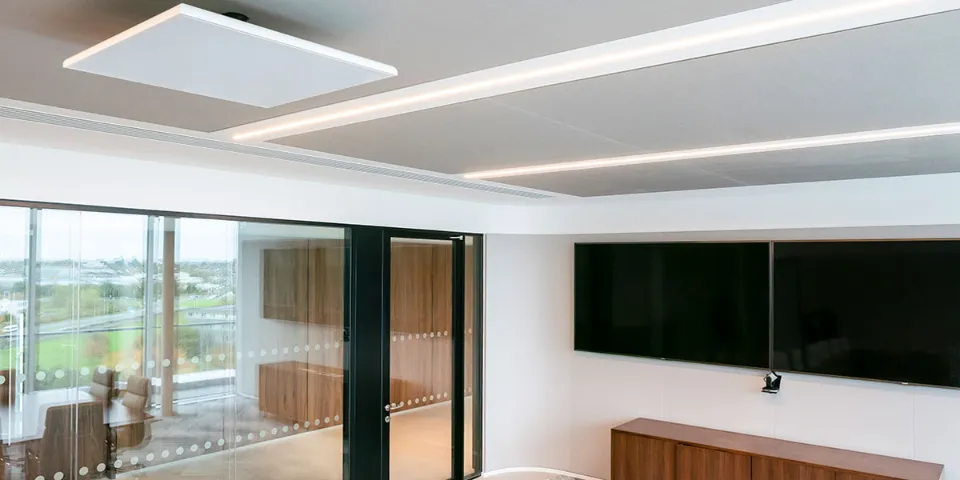Introduction to Ceiling Tiles
How often have you walked into a space and felt overwhelmed by noise immediately or perhaps struggled to focus in your workplace due to constant chatter? From low-frequency noises to high-pitched squeals, each sound carries its peculiarities and affects productivity and well-being differently. By offering you the right ceiling tiles in Ireland, we understand the importance of frequency, not just in sound but also in selecting the right option for your specific noise challenges.
The Many Faces of Noise
Not every noise is equal: our sound perception is heavily influenced by frequency, which refers to the number of vibrations a sound wave makes per second. Hertz (Hz) is the measuring unit of frequency, which determines each pitch, ranging from the “shrill” sounds of higher frequencies to the “deep” sounding of lower frequencies. In concrete, high frequencies are generated by elevated vibrations per second. On the contrary, the lower the frequency, the fewer vibrations per second. For example, the machinery’ continuous hum might be dominated by low frequencies, while office chatter is a mix of mid and high frequencies due to various human voices.
The way we perceive sound is heavily influenced by its frequency. Therefore, it becomes crucial when tackling noise issues in our environments. Here’s an overview of frequency ranges:
- Low Frequencies (20 Hz—250 Hz): To our ear, these often register as a rumble or hum, such as the noises of highways, air conditioners, and even our footsteps. Low frequencies may be irritating since they can easily penetrate walls and floors.
- Mid Frequencies range (250 Hz – 4,000 Hz): This range is where a significant portion of our daily noise pollution resides. It includes most human speeches and ordinary office sounds like phone calls, keyboard clicks and conversations.
- High Frequencies range (4,000 Hz—20,000 Hz): We perceive these frequencies as sharp or shrill, such as alarms, sirens, screeching brakes, and even the high notes of some musical instruments. Even though they generally are less bothersome in terms of loudness perception, high frequencies can cause irritation and fatigue over time.
The human ear has a natural hearing range of approximately 20 Hz and 20,000 Hz. However, our sensitivity to these frequencies can vary. We are generally more sensitive to mid-range frequencies, which explains why human speech is clear even in noisy environments.
Beyond Aesthetics: Addressing Functionality
We have established that frequency matters when tackling noise issues. But suspended ceiling tiles offer more than just sound absorption. Let’s delve deeper and explore their innovative materials, designs, and functionalities that allow our ceiling panels to contribute to a better environment.
The Noise Reduction Coefficient (NRC) ranges from 0 (no sound absorption) to 1 (complete absorption). Remember this guideline when evaluating suspended ceiling tiles’ sound absorption capabilities: the higher the NRC, the better the soundproofing. Acoustic ceiling solutions can meet a wide range of your specific needs, in particular:
- Echo Reduction: for mitigating reverberation in large spaces like auditoriums and open-plan offices.
- Speech Privacy: for environments requiring confidentiality, where noise is minimised to promote focused work.
- Noise Blocking: for those situations where outside noises need to be contrasted.

Designing Spaces with Style and Sustainability
Nowadays, sustainable design choices are no longer just a trend; they are a necessity. Here at Vibe by Vision, we understand that creating an aesthetic and functional space shouldn’t come at the expense of the environment, so let’s explore the ways our ceiling tiles in Ireland make this possible.
First, each of our suspended ceiling tiles is made of low-VOC (volatile organic compound) Emission materials. Not only that but our ceiling tiles are made of a relevant percentage of recycled materials to minimise the environmental impact of production and promote a circular economy. Then, we manage to integrate your interiors, combining each designed solution with a wide range of sustainable materials such as:
- Mineral fibre panels for excellent mid-range frequency absorption are ideal for taming office chatter.
- Fibreglass panels offer an optimal balance of sound absorption across the frequency spectrum, making them a versatile choice.
- Metal panels are suited for applications where blocking sound transmission is the primary concern.
Lastly, as for size and style, larger tiles can provide more overall sound absorption, whereas smaller tiles with textured surfaces are better suited for specific frequencies.
Case studies
Here are some examples of how choosing the right ceiling tiles can dramatically improve acoustics in different environments in real-world scenarios:
Scenario 1: Busy Open Office
Imagine yourself in a rumorous open-plan office: phone calls, conversations, and keyboard clicks that impede effective communication and lower focus and productivity. In this case, Vibrating ceiling tiles with a high NRC rating and good mid-frequency absorption, like mineral fibre tiles, can help quiet the bustle of the busy environment. These specific ceiling panels can create a calmer, more focused work environment by absorbing the chatter’s dominant frequencies.

Scenario 2: Noisy Classroom
Uncontrolled classroom noise and low-frequency traffic noises from outside can hinder students’ concentration and learning. Fibreglass ceiling tiles can be an excellent solution due to their even sound attenuation across the spectrum. They effectively absorb both low-frequency traffic noise and the mid-frequency sounds of student interaction, enhancing learning conditions.

Scenario 3: Home Studio
Aspiring musicians and podcasters often struggle with unwanted noise in their home studios. The goal here is to minimise echo and ensure clear sound recordings. Fabric-textured panels can help diffuse sound waves and reduce reverberation while creating a more controlled acoustic environment for capturing high-quality audio.

Conclusion
Transform your space with our innovative suspended ceiling tiles in Ireland. Enhance functionality while seamlessly addressing noise issues. Explore all of our solutions for a customised acoustic experience. Discover more on our website!


